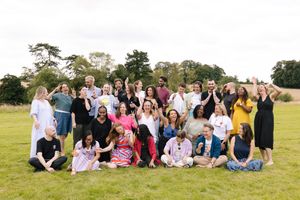
5 things to understand about your brain before you innovate
Innovation demands new ways of thinking and doing, or novel ways of stitching existing ideas together to come up with a better solution. As we know from Einstein, “we cannot solve our problems with the same thinking that created them.”
But there’s a technical hitch: your brain will always try to solve a problem based on what’s worked in the past. This is because your brain is super efficient and loves to save energy.
So what can we better understand about our brains in order to consciously move into more creative modes and come up with those new solutions?
1) Your brain is always planning ahead
Remember how our brains like to take the easiest path? Well, that means brains love to know what’s happening. They crave certainty.
Uncertainty, then, is super taxing for our brains. The unknown sets our brain whirring, trying to guess what will happen. To create certainty our brain makes up stories about what might happen. From there, it can try and keep us safe.
You know those times when you don’t get a quick reply to a message you have sent, when your colleague is frowning when you’re talking, or when you know there’s change coming in your organisation? Your brain runs through possibilities, often assuming the worst.
In a bid to reduce uncertainty, our brain uses valuable energy trying to look ahead and anticipate what might happen. So how can we hack this system and use it to our advantage?
If we prime our brains with a prompt or creative challenge, we shift the uncertainty from what will happen to how it will happen. Once we have primed the brain to think about something, it will keep working even while we’re busy doing something else.
Think about a time when you have lost a word or an important fact. You’ve primed your brain to look for some information, and while you go about your day, your brain is working on it in the background. Then hey presto! The word will pop into your head later.
To capitalise on this brain trait, try asking a question or articulating a challenge at the start of a week or month. When ideas pop into your head, note them down so your mind is free to move on (you don’t want it spending energy holding onto the idea!). At the end of the week or month, take some time to come back to the question or challenge and see what emerges for you.
Another approach to make this work for you is to ‘think backwards’. Think about where you’d like to get to and allow yourself to dream about how you will get there. Anchoring to the future helps you keep your goal in mind, so you can seize opportunities that will help you move towards it.
To supersize this, take a moment to visualise how you will feel (and what the world will look like) when you’ve answered the question, or solved the challenge. The brain can’t tell the difference between imagined and real life (visualising uses the same circuitry as your experiences) so your brain will get an anticipatory reward that comes with a kick of motivation to pursue your goal!
2) Your brain fuses ideas together to create new ideas
Our most creative ideas come when our brains make connections between seemingly unconnected ideas. This process is called ‘conceptual blending’.
If you put very similar ideas together, you’ll get very similar ideas out. Widen the range and diversity of ideas or inputs bouncing around in your head and you increase the chance of an unusual combination, and a novel idea.

Bachrach, who wrote the book ‘the Agile Mind’ uses a beautiful metaphor to describe this. He describes thoughts or ideas as being like liquids, free to combine… until, that is, our typical mode of thinking separates, segments and categorises them, freezing ideas into separate ice cubes that can’t combine.
Typically, when we try to solve a problem like, for example, ‘how to improve a swimming pool’, we automatically unfreeze the ‘swimming pool’ cube which means our ideas are already constrained by our existing thinking and will only get marginally better. To be innovative, we want to allow random ideas to mix together.
To do this, we need both more ideas, and the mindset and moments to let the ideas combine (which we’ll come to in the next point).
When you feel stuck or craving a creative boost, resist the instinct to double down on the topic you are working on. When we are trying to solve something, we tend to concentrate deep on the topic, reading and thinking about things directly related.
Instead, widen your gaze, and with it increase the stimuli to your brain. Try things that capture your imagination like reading something totally different (science fiction or poetry), listening to music, watching a play, looking at art, or trying a clowning or improvisation class.
If you feel stuck for words typed on a page, try drawing or writing in a notepad. Follow your fingers, without thinking too much, and you will be surprised what emerges.
3) Your brain can’t be creative if it’s always busy
No matter what great stuff you’ve got in your brain, your brain only has a chance to make connections (and even notice your ideas) if you create some space.
In the same way stars are only visible at night (even though they are there all the time), ideas may remain eclipsed by a cacophony of business, only showing themselves when the mind calms and we are relaxed. (thanks again to Bachrach for the metaphor!).
During these times our Default Mode Network engages. Think of the DMN like a light switch… it can only turn on when you turn your brain off from tasks. Your DMN allows you to process all the ‘stuff’ in your brain. Imagine it like a big broom, sweeping through through all the activities, information and tasks in your brain. It piles up and chucks out the bits you don’t need. It moves things around, bringing different pieces of information to the top, connecting things together in new ways. Your DMN sifts through to find information related to problems that need to be solved (finding it in unexpected places, as mentioned above). While activated, your DMN helps you process experiences, consolidate learning, understand the experiences and feelings of others and organises your thoughts.
Mind wandering (and rest!) are really important for your brain to forge connections and tell you about them!

Alternate focused activity with doing something different. This might be doing sport, yoga, meditation, cooking, gardening, walking in nature… something where you are deliberately not engaging your thinking brain. This will create the dark needed for the stars to emerge!
4) Your brain shuts down (and shrinks!) when it’s anxious
Another benefit of taking time for mind wandering (engaging your DMN) is that it literally recharges your brain battery.
When we are stressed or triggered, blood and oxygen rushes from our rational, thinking brain to our limbic system. The limbic system is the oldest part of our brain, responsible for our ‘fight, flight, freeze’ reaction. This ancient system is designed to keep us safe. It releases a burst of energy (adrenaline and cortisol) so our bodies can respond. What’s important to remember is that it was also designed to be intermittent, activated and then turned off.
Turning the stress off is something we’re not so good at these days. Rather than short periods of acute stress, many of us are living with chronic stress which keeps our brain alert and flooded with cortisol.
One impact of this is that people who report high levels of stress have been found to have a 20% smaller prefrontal cortex. The PFC is the ‘rational’ part of the brain, responsible for focus, planning, making decisions and self control.
You will probably notice for yourself that when you’re stressed it’s harder to plan, to learn, to empathise or to control your impulses!
So while we need our brains to be in ‘drifting’ mode to make connections between ideas, stress pulls us into a different place and makes that much harder.
When you are stressed or feel on edge, you’ll notice that it also becomes harder to open up to others, to learn or to collaborate. Openness is critical for innovation, so building a culture of psychological safety is antidote to this.
You might be spotting a theme here: be intentional about taking time out to recharge your brain. That looks different for different people, but again, spending time doing things that are physical or mindful (a walk, exercise, watering plants for example), away from screens are super useful.
Neuroscientists at Harvard have seen brains grow after as little as 8 weeks of regular yoga and meditation. Use what you can to decrease stress!
It’s not all about turning off the screens though. When you’re triggered and need your PFC to re-engage, try Dan Siegel’s technique and ‘name it to tame it’. If you can articulate what has sparked a limbic reaction, you will already be reengaging your PFC. The SCARF model gives some great vocabulary to help you identify what might have happened. (Check out my ‘managing uncertainty when your brain doesn’t like it’ blog for more on that.)
5) Your brain releases a hit of energy when you have an insight
You’ve been pouring brilliant, diverse stimuli into your brain. You’ve primed your brain with a challenge. You’ve built in time for those ideas to fuse together. You’ve reduced stress.
And you’re rewarded by that beautiful moment… a ping of insight. A moment of innovation.
It really is glorious. A gamma burst. A group of neurons firing together. And they set off a chorus inside you. Remember that feeling??
An insight comes with a burst of energy that gives you focus and courage to act. This is what you’ve been waiting for and this is a ‘use it or lose it’ type moment.
When you have the brain wave, do something about it. Rather than leaving an idea in the confines of your imagination to be forgotten, do what you can to capture it. Call someone, write it down, record a voice note in your phone. Perhaps even take the first step, or pop some time in your calendar to do it, so you can bring your insight to life.




